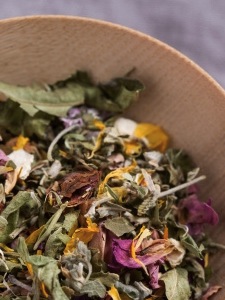Devising Wellness Blends
As tea grows in popularity the notion that tea is a medicine of sorts grows along with it. The traditional correlation between tea and good health is a strong one and leaves the every day consumer asking, "What will this tea do for me?" We’ve all answered this question with the general health benefits of drinking various tea types, but at some point you may be inclined to dabble in various herbs and try your hand at blending that which your customers seek.

When endeavoring to blend herbs into a special concoction, keep safety first in mind. This calls for research into each ingredient and any contraindications for special conditions, such as pregnancy, nursing, hypertension, etc. Don’t merely use Wikipedia as your guide. Check the sources listed for each article and delve deeper. Make sure any information is backed up by reliable studies conducted by well-known organizations.
When blending, taste is not as important with wellness blends as it is with those enjoyed solely for flavor, as people expect them to be medicinal. That said, if they are more palatable, the customer is more likely to consume them and return for more! Often peppermint, licorice root, and cinnamon are added to wellness blends, not only for their own contribution to wellness but also to sweeten or hide off-putting notes in an herbal blend. They are a helpful, healthful way to add flavor and bury unpleasant tastes.
Rooibos and its sister, honeybush, make great bases for wellness teas, adding body and sweetness while imparting their own lovely benefits such as antioxidants and stress relief. Consider them as a framework on which to build the tisane of your customers' desire.

